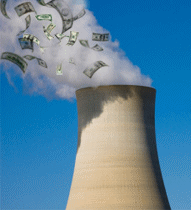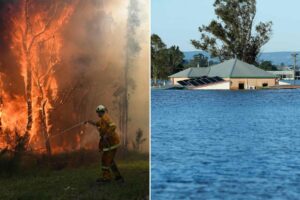On March 11, 2011, the Fukushima Daiichi nuclear power plant north of Tokyo was hit by a wall of water 43 feet high that destroyed or disabled enough equipment to cause three reactors to melt down.
Two years later, the people of Japan are bouncing back. The nuclear industry, not so much.
The United States has not (yet) built a new nuclear reactor since1996 — new U.S. nuclear capacity has essentially flatlined. The U.S. still has far more nuclear power generation than any other country, though China, Russia, India, and Korea are actively constructing new reactors. A few U.S. building permits have trickled in since 2007, when an energy bill with incentives for new nuclear plants passed Congress. The Wall Street Journal reported in December that:
The first newly licensed nuclear-power plant to be built in the U.S. in decades, the Vogtle project in Georgia, has run into construction problems and may be falling years behind schedule, according to an engineering expert advising the state.
Nuclear power may continue to be a small wedge of our energy pie, but it is still not going to be more than a small wedge of the solution to human-caused climate change. Here’s why.
COST
A new nuclear reactor will set you back a cool $10 billion or more. The Department of Energy is promoting a plan to build as many as 50 small modular reactors per year starting in 2040. Constructed in factories, these reactors would cost “only” $3-5 billion each.
But before they even get to building a new reactor, the nuclear industry has relied upon about ten times as much in federal subsidies compared to those reluctantly offered to renewable energy developers. This is important to keep in mind as the industry complains about wind energy subsidies lowering electricity prices.
One of the arguments the nuclear industry has made over the last several decades is that though it is expensive right now, once the industry learns how to construct plants again, the financial structure changes as costs drop. This appears to be the opposite of true: Nuclear power has a negative learning curve.

Average and min/max reactor construction costs per year of completion date for US and France versus cumulative capacity completed.
Nuclear power has always been very expensive, and will continue to be staggeringly so, especially if we are to build in safety and redundancy measures needed to avoid future Fukushimas.
SAFETY

Japan faces combined clean up and compensation costs at Fukushima estimated to reach $500 billion. The timeline for decommissioning the ruined plant is 30-40 years. There is a $6 million robot deployed to inspect the damaged hallways that got lost in the plant and has not been seen for 17 months. And the cost estimates are just guesswork:
Cleaning up the mess will mean total demolition of the four damaged reactor facilities and disposal of the nuclear waste in a yet-to-be determined site, an end-game likely to face opposition from potential host communities.
Japan has rejected the “sarcophagus” option used at Chernobyl, where the damaged reactor was encased in a massive concrete envelope. This is partly because of the difficulty of monitoring an entombed facility to ensure safety, said Kentaro Funaki, director of the industry ministry’s office in charge of decommissioning.
Estimates for total costs are mostly guesswork. “Only God knows,” said Chuo University’s Annen.
Whatever the final bill, Japanese consumers are likely to end up paying much of it, either through taxes, higher electricity rates or both, even as Japan’s government struggles with massive public debt and the costs of an ageing population.
If you ask the Nuclear Regulatory Commission about the safety record of U.S. reactors (as theAssociated Press did), they would say “the performance is quite good.” Only five out of 104 reactors had safety issues at the end of the year. However, a Union of Concerned Scientists report found that during the whole year, 40 out of the 104 had at least one serious safety incident. Thismap shows you the locations of 12 reactors that almost melted down in 2012.
Are U.S. reactors learning from the Fukushima accident? Not really:
Even before the new rules are completely in place, the NRC is considering a new regulation related to the Japan disaster: requiring nuclear operators to spend tens of millions of dollars to install filtered vents at two dozen reactors.
NRC staff recommended the filters as a way to prevent radioactive particles from escaping into the atmosphere after a core meltdown. The filters are required in Japan and throughout much of Europe, but U.S. utilities say they are unnecessary and expensive.
The Nuclear Energy Institute said filters may work in some situations, but not all. … “We’re not against filtering. It’s how you achieve it,” said Marvin Fertel, the group’s president and CEO. …
“It’s not the time to be rash with hasty new rules, especially when the NRC has added 40-plus ‘safety enhancements’ ” to its initial requirements following the Japan disaster, said Sen. David Vitter, R-La., senior Republican on the Senate Environment and Public Works Committee.
Emissions
The only reason people consider nuclear as an alternative to fossil fuels is due to relatively low lifecycle emissions. Greenhouse gas emissions from nuclear energy are low enough to be in the range of many other renewable forms of electricity generation. Their emissions occur not during electricity production, but through everything else required to commission and decommission a nuclear plant: “plant construction, operation, uranium mining and milling, and plant decommissioning.”
The problem is you couldn’t build the reactors fast enough to make a difference. Even prior to the disaster at the Fukushima reactor, nuclear power was never a climate cure-all as we reported back in 2007: If the world built about 2 nuclear plants each month for 50 years — along with some 10 Yucca Mountains to store the waste – nuclear power would still be under one-tenth of the solution to global warming.”
Those numbers make clear nuclear power will not be a large piece of the pie in lowering emissions to stabilize below 450ppm.
Waste
The availability and security of nuclear waste storage are unresolved problems. The courts havedecided that the executive branch and the states need to resolve the issue of where to put the waste, and all they appear to have concluded in three decades is “not in Nevada.”
The issue of where to put the growing national pile of nuclear waste (2,000 tons a year in spent fuel alone) is unlikely to be resolved in the next three decades. Whatever the solution ultimately is, it won’t come cheap.
What do proponents say about waste concerns? “Blah, blah, blah.”
Water

One nuclear reactor uses 35-65 million litres of water each day. Large mounts of water are also used in the uranium mining process.
Two plants in Georgia use more water than all the water used by people living in Atlanta, Augusta and Savannah combined.
* * *
Climate hawks have always had an ambivalent relationship with electricity powered by nuclear fission, primarily because, while it is low-carbon, it is so damn expensive. So although we have a hundred or so plants in the U.S. that will be with us for the foreseeable future, it is much more cost-effective to continue to promote and rely on truly clean, cost-effective renewable energy and energy efficiency.










